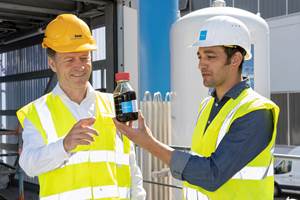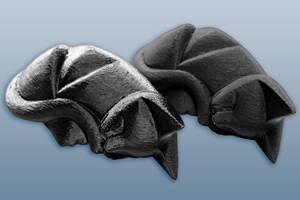New Compounding Options Strengthen Pull of Molded Magnets
Thermoplastic polymer-bonded magnets are exerting a stronger pull on designers of motors, valves, sensors, and other electronic devices used in cars, telecommunications devices, and large appliances. The attraction is strongest in applications demanding greater design freedom than is offered by conventional magnets sintered from 100% metal powder.
"There's growing interest among magnet makers in compounds that are injection moldable," states Edward Hallahan, product manager for polymer-bonded magnetic compounds (PBMCs) at Ticona in Summit, N.J. PBMCs contain high loadings of magnetic powder (up to about 60% by volume, 90% by weight) dispersed in a polymer matrix. Hallahan says injection molded magnets are gaining ground because they can be given more intricate shapes without costly machining steps. Also, sintered magnets (as well as compression molded thermoset PBMCs) are said to be more prone to breakage and chipping.
David Jarvis, PBMC market manager at EMS-Chemie (North America) Inc., Sumter, S.C., estimates PB magnet growth rates at 10%/yr in the U.S. and 15-20%/yr in Europe. He links increased demand to continuing miniaturization of electronics. He also points to product end-use environments that pose greater challenges in terms of thermal and chemical aggressiveness.
Thermoplastic PB magnets have been made for decades, mostly by specialized magnet manufacturers well outside the mainstream of plastics processing. In the 1990s, new PBM applications like air-bag sensors and CD/DVD spindle drives were developed by the top magnet makers such as Group Arnold in Marengo, Ill.; Kane Magnetics International in Loveland, Ohio, and Solihull, England; and Tengam in Oswego, Mich. These companies developed their own expertise in compounding and molding of magnets, and they keep their secrets close to the vest. Most do their own compounding in-house but also use some Japanese-made compounds. Dainippon International, for instance, supplies PBMCs in the U.S. through its subsidiary in Fort Lee, N.J.
The time now appears ripe for custom compounders and molders to open up the closely held world of PB magnets. For one thing, more designers are open to the advantages of PBMCs. Also, OEMs and Tier One molders are looking for new ways to exploit their electronics know-how. In-house PB magnet molding is one opportunity.
Fewer property tradeoffs
The Achilles' heel of thermoplastic PB magnets is their inability to equal the magnetic power of conventional magnets. This holds for "hard" (permanent) magnets, whose strength is measured in terms of maximum energy product (BH max) in kJ/m3 and for "soft" magnets (which become magnetized in response to an electromagnetic field) measured in terms of permeability (kJ/m3).
Strength of PB magnets is limited because the key determinant of magnetic power is the volume content of magnetic material. That is 100% for sintered metal and 98% for thermoset-bonded magnets (typically 2% epoxy binder). In contrast, the volume ceiling for thermoplastic magnets is 60%, and their potency is correspondingly lower.
Gerhardt Reuschel, a Ticona PB magnet specialist, argues that Ticona's products are viable when other benefits outweigh this deficit. He notes that PBMCs impart higher mechanical load-bearing performance than other magnets, as seen in the flexural strength of Ticona's grades, which is at least double that of sintered magnets. PBMCs also allow complex shapes and magnetic fields to be designed into the magnet.
What's more, thermoplastic PB magnets are improving in both magnetic and mechanical properties. A number of PBMC suppliers are now using neodymium-iron-boron, an emerging class of rare-earth magnetic powder. Nd-Fe-B alloy offers greater magnetic strength than conventional ferrites. It has helped unlock new roles for PB magnets in DVD disk drives and automotive uses. But it is also harder to compound, less corrosion resistant, and more costly than conventional ferrite magnetic powders.
Ticona has just launched a family of Fortron PPS magnet compounds, which are said to provide better chemical and temperature resistance than existing PBMCs, most of which are based on nylon 6, 66, and 12. Superior dimensional stability is another claimed advantage. Ticona views these attributes as increasingly important in view of the more challenging way magnets are being used (e.g., in high-speed rotation) and assembled (with high soldering temperatures).
Ticona's PPS-based compounds include hard and soft magnet grades. At present, they contain only ferrites, although Ticona is exploring use of Nd-Fe-B. Ticona's soft grades have specific gravities of 2.8 to 3.6 and permeabilities of 2.2 to 15 kJ/m3. They are tailored for specific roles like the toner sensors in copying machines, duplexers in cellular phones, and inductor cases in LCD lighting. Reuschel views the ability of soft magnets to absorb, dampen, deflect, or shield against surrounding electromagnetism as a major growth driver.
The Ticona hard grades include some for isotropic magnets (in which particles are arranged randomly) and others for anisotropic magnets. In the latter, magnetic particles must be "frozen" with the desired orientation when the compound is still in a semi-molten state. Special magnetizable molds and magnetizing jigs are needed to make them. Applications for Ticona's hard grades are speed and rotation sensors in cars, flow-control valves in air conditioners, and position sensors in disk drives. Fortron magnet compounds are priced at $10 to $15/lb.
Ticona officials say both soft and permanent isotropic magnets can be molded on conventional injection presses. However, the hard ferrite particles require that molds be made of hardened steels to protect against abrasion. Ticona recommends boride-hardened steel for screws and barrels, and micro-grained tungsten steel for gates.
EMS-Chemie introduced its PBMC slate in Europe in the mid-1990s. Its initial products were based on Grilamid nylon 12 and utilized conventional ferrite powders. Now, the Grilamid PBMC family also uses Nd-Fe-B in a range of metallic content of 78% to 92% by weight (50% to 65% by volume). BH max values of hard magnetic grades range from 15 to 50 kJ/m3.
To meet demanding end-uses, EMS-Chemie is now introducing a new line of PBMCs based on high-temperature, partially aromatic nylon sold under the Grivory HT trade name. Some Grivory compounds use standard ferrites, but others contain Nd-Fe-B magnetic filler. Three products of 88% by weight Nd-Fe-B are offered for short- and long-term high-temperature exposure, as well as for electric-motor (high-coercivity) markets.
EMS's Jarvis argues that nylon-based PBMCs have performance advantages over PPS versions—one being their acceptance of higher loadings of magnetic filler, which imparts higher magnetic strength. In addition, nylons are 10-20% lower in density than PPS, which translates into a lower cost per cubic inch in molded parts.
EMS-Chemie also says Grivory grades using Nd-Fe-B have advantages over equivalent compounds made with PPS. These include higher impact strength and ultimate elongation, as well as a slightly higher HDT. Another benefit claimed for high-heat nylon products is better recyclability. This is important when Nd-Fe-B is used, since the alloy costs at least $40/lb, putting a premium on scrap reuse. EMS's data indicate that at various levels of regrind use, Grivory grades remain more ductile, stronger, and tougher than PPS magnet compounds.
New thermoplastic materials technology has potential for producing more powerful PB magnets. A reactive thermoplastic system in development by Cyclics Corp., Rensselaer, N.Y., utilizes cyclic oligomers of low molecular weight and water-like viscosity. Their low viscosity permits incorporating metal fillers and reinforcements at up to 80% by weight. Once injected into a mold, a catalyst causes the oligomers to polymerize into high-molecular-weight engineering thermoplastics like polycarbonate or PBT. The company reports customer interest in using cyclics for molding magnets to be used in association with higher-voltage (42-V) batteries being tested for automotive electronics.
More PBM players
Compounders RTP Co., Winona, Minn., and LNP Engineering Plastics in Exton, Pa., supply soft-magnet compounds. Both companies are expert in formulating with high filler loadings. Not surprisingly, they expect to increase their role in the magnet market in the near future.
Bulk Molding Compounds Inc. in Chicago supplies thermosets for compression molding of magnets. Its BMC 750 Series compounds are said to produce magnets that do not need a supportive plastic coating.
MagneQuench of Anderson, Ind., the only domestic supplier of Nd-Fe-B magnetic powders, also makes Ne-Fe-B sintered magnets. It recently acquired a top molder of PB magnets, Widia Magnet Engineering in Essen, Germany. MagneQuench has since launched the MQ3 line of molded magnets in which the magnetic particles are aligned in the flow direction to make powerful anisotropic permanent magnets.
Meanwhile, on May 8, MagneQuench filed two lawsuits in the U.S. against 10 giant electronic and computer manufacturers, arguing that the Nd-Fe-B plastic magnets used in their products violate MagneQuench's patent on magnet applications of the alloy. (Sources indicate that the issue involves Chinese-made magnets that use Nd-Fe-B alloy from Chinese sources not licensed by MagneQuench.)
Another PB magnet maker, Kane Magnetics, compounds and molds Ne-Fe-B magnets as small as 0.5 g. A Kane subsidiary, Anchor Magnets in Sheffield, England, recently launched an easy-to-handle yet powerful signage suspension system called Mag-Edge. This utilizes Ne-Fe-B to achieve high bonding strength in plastic strips 3 mm wide and 0.7 mm thick. The magnetic compound is coextruded with a supporting plastic layer.
Stephen Bullen, Kane's group marketing director, notes that Kane recently acquired C2B Magnets in Auxonne, France. That company is a leader in sintered magnets and has developed a method for overmolding them with a plastic protective skin.
Group Arnold compounds and molds Plastiform HS magnets from nylon and PPS. It uses rare-earth alloys of Nd-Fe-B and samarium-cobalt. —Robert Leaversuch
Related Content
BASF to Purchase Pyrolysis Oil Produced From Waste Plastics
Agreement with Arcus Greencycling GMBH anticipates a volume of 100,000 ton/yr.
Read More3 Types of 3D Printed Tooling for Injection Molding
3D printed tooling for injection molding, including mold inserts, components and end of arm tooling, were on display at the Plastics Technology Expo.
Read MoreMasterbatches Reduce Gloss in PLA and PETG 3D Printed Products
Insight Polymers & Compounding’s two low-gloss additive masterbatches shown to boost appearance of 3D printed objects.
Read MoreUnderstanding the ‘Science’ of Color
And as with all sciences, there are fundamentals that must be considered to do color right. Here’s a helpful start.
Read MoreRead Next
Understanding Melting in Single-Screw Extruders
You can better visualize the melting process by “flipping” the observation point so that the barrel appears to be turning clockwise around a stationary screw.
Read MoreHow Polymer Melts in Single-Screw Extruders
Understanding how polymer melts in a single-screw extruder could help you optimize your screw design to eliminate defect-causing solid polymer fragments.
Read More.png;maxWidth=970;quality=90)












.png;maxWidth=300;quality=90)














